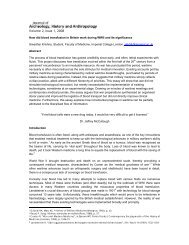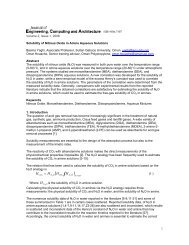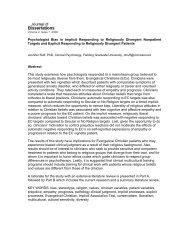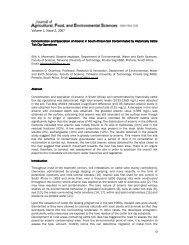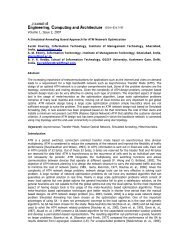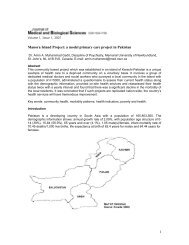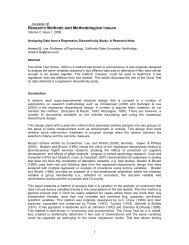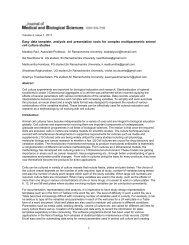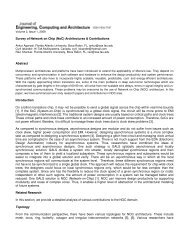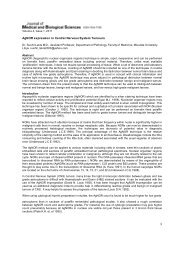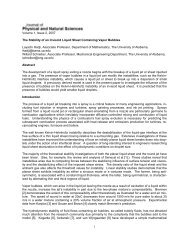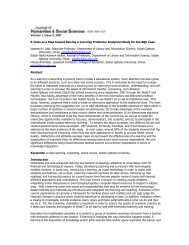The Heaven and Earth Society and the Red Turban Rebellion in ...
The Heaven and Earth Society and the Red Turban Rebellion in ...
The Heaven and Earth Society and the Red Turban Rebellion in ...
You also want an ePaper? Increase the reach of your titles
YUMPU automatically turns print PDFs into web optimized ePapers that Google loves.
social composition of <strong>the</strong> <strong>Red</strong> <strong>Turban</strong> rebels was no simple, static matter, but ra<strong>the</strong>r tempered by regional<br />
variation. 104 For <strong>in</strong>stance, <strong>the</strong> local Ti<strong>and</strong>ihui lodges often took advantage of o<strong>the</strong>r ongo<strong>in</strong>g feuds to enhance<br />
<strong>the</strong>ir position. One of <strong>the</strong> most endur<strong>in</strong>g such feuds was <strong>the</strong> ethnic struggle between <strong>the</strong> Punti <strong>and</strong> <strong>the</strong><br />
Hakka <strong>in</strong> <strong>the</strong> wuyi regions. 105 Even though <strong>the</strong> Hakka had been falsely accused by <strong>the</strong> Punti of be<strong>in</strong>g <strong>Red</strong><br />
<strong>Turban</strong> rebels, 106 archival records of <strong>the</strong> rebel participants <strong>in</strong> Central Guangdong such as <strong>the</strong> local<br />
gazetteers from Enp<strong>in</strong>g <strong>and</strong> Kaip<strong>in</strong>g counties, 107 on <strong>the</strong> contrary, show that one group of people st<strong>and</strong>s out<br />
because <strong>the</strong>y are mostly absent: <strong>the</strong> Hakka. 108 <strong>The</strong>re were certa<strong>in</strong>ly some Hakkas among <strong>the</strong> <strong>Red</strong> <strong>Turban</strong>s<br />
but most of <strong>the</strong> Hakka rebel participants were from Eastern Guangdong. 109 But <strong>in</strong> view of what happened<br />
later, <strong>the</strong>re seems no doubt that, <strong>in</strong> <strong>the</strong> districts to <strong>the</strong> west of Guangzhou, <strong>the</strong> wuyi regions, most of <strong>the</strong><br />
rebels were <strong>the</strong> Punti. 110<br />
<strong>The</strong> Ti<strong>and</strong>ihui memberships were more numerous <strong>in</strong> <strong>the</strong> wuyi regions dur<strong>in</strong>g <strong>the</strong> mid-n<strong>in</strong>eteenth<br />
century, <strong>in</strong> part because <strong>the</strong> mass emigrations of <strong>the</strong> early n<strong>in</strong>eteenth century, when millions fled from<br />
starvation. <strong>The</strong>se new settlers provided eager recruits for <strong>the</strong> protection that Ti<strong>and</strong>ihui membership offered,<br />
<strong>and</strong> might even utilize <strong>the</strong>ir Ti<strong>and</strong>ihui affiliations to launch attacks aga<strong>in</strong>st <strong>the</strong>ir more long-st<strong>and</strong><strong>in</strong>g neighbors,<br />
<strong>the</strong> Hakkas. <strong>The</strong> Hakkas might well form militias aid<strong>in</strong>g Q<strong>in</strong>g forces <strong>in</strong> turn, to secure once aga<strong>in</strong> greater<br />
organizational <strong>and</strong> numerical strength aga<strong>in</strong>st <strong>the</strong> newcomers. 111<br />
<strong>Red</strong> <strong>Turban</strong> efforts to recruit wuyi people <strong>in</strong>creased <strong>in</strong> 1855 <strong>and</strong> cont<strong>in</strong>ued <strong>in</strong> <strong>the</strong> period<br />
immediately follow<strong>in</strong>g <strong>the</strong> first Ti<strong>and</strong>ihui attack on Guangzhou. However, <strong>in</strong>terethnic hostility proved to be<br />
more powerful than ei<strong>the</strong>r <strong>the</strong> Ti<strong>and</strong>ihui “cause” or general popular animosity toward <strong>the</strong> Q<strong>in</strong>g state. In late<br />
1854, ethnic strife pushed <strong>the</strong> Punti tenants <strong>and</strong> vagabonds <strong>in</strong> Heshan county <strong>in</strong>to an open rebellion under<br />
<strong>the</strong> guidance of Liang Peiyou. Although local details of rebel organization <strong>in</strong> <strong>the</strong> Heshan at <strong>the</strong> time are<br />
scare, sources clearly <strong>in</strong>dicated that Punti resentment of <strong>the</strong> Hakka have been a subsidiary cause of <strong>the</strong><br />
<strong>Red</strong> <strong>Turban</strong> <strong>Rebellion</strong>. 112<br />
In this sense, ethnicity was central to <strong>the</strong> cause of <strong>the</strong> rebellion especially <strong>in</strong> <strong>the</strong> wuyi regions. At<br />
<strong>the</strong> same time, ethnic division also expla<strong>in</strong>s <strong>the</strong> failure of <strong>the</strong> rebellion. Before <strong>the</strong> arrival of Q<strong>in</strong>g forces, <strong>the</strong><br />
rebels’ ma<strong>in</strong> opponents were ethnically organized bodies of Hakka militias. Local Ti<strong>and</strong>ihui leader, for<br />
<strong>in</strong>stance, Liang Peiyou <strong>in</strong> X<strong>in</strong>’n<strong>in</strong>g could not have raised forces district-wide without <strong>the</strong> mobiliz<strong>in</strong>g power of<br />
ethnic anger, <strong>and</strong> <strong>the</strong> Q<strong>in</strong>g fight aga<strong>in</strong>st <strong>the</strong> <strong>Red</strong> <strong>Turban</strong> rebels would have been even more protracted<br />
without <strong>the</strong> aid of <strong>the</strong> similarly motivated Hakka militia. <strong>Red</strong> <strong>Turban</strong>’s efforts to forge a pan ethnic alliance<br />
104 <strong>The</strong> types of <strong>Red</strong> <strong>Turban</strong> groups also varied along with differences <strong>in</strong> cropp<strong>in</strong>g <strong>and</strong> l<strong>and</strong>hold<strong>in</strong>g patterns.<br />
For <strong>in</strong>stance, Nor<strong>the</strong>astern Guangdong, with a less productive agriculture based upon wheat , maize, <strong>and</strong><br />
beans, was <strong>the</strong> home of more egalitarian <strong>Red</strong> <strong>Turban</strong> units <strong>in</strong> which <strong>the</strong> leaders—often peasants<br />
<strong>the</strong>mselves—were treated as bro<strong>the</strong>rs. Central region saw <strong>the</strong> development of <strong>Red</strong> <strong>Turban</strong> units comprised<br />
of demobilized soldiers, brig<strong>and</strong>s, <strong>and</strong> local bullies. On <strong>the</strong> o<strong>the</strong>r h<strong>and</strong>, <strong>the</strong> wuyi regions of <strong>the</strong> Central<br />
Guangdong, known for productive wet-rice cultivation <strong>and</strong> high rates of tenancy, saw Punti tenant<br />
dom<strong>in</strong>ated <strong>Red</strong> <strong>Turban</strong> units known as a tang. See Yoo, Kundae, 258-275.<br />
105 <strong>The</strong> term "Hakka" (kejia 客 家 <strong>in</strong> M<strong>and</strong>ar<strong>in</strong>, mean<strong>in</strong>g literally "guest people") usually <strong>in</strong>dicates an<br />
immigrant population <strong>in</strong> sou<strong>the</strong>rn Ch<strong>in</strong>a, dist<strong>in</strong>guished from <strong>the</strong> Punti (bendiren 本 地 人 , natives) primarily<br />
by dialect. <strong>The</strong> l<strong>in</strong>e of demarcation between <strong>the</strong> Punti <strong>and</strong> <strong>the</strong> Hakkas that lived <strong>in</strong> some parts of<br />
Guangdong (Enp<strong>in</strong>g, Gaom<strong>in</strong>g, Heshan, Kaip<strong>in</strong>g, X<strong>in</strong>hui, <strong>and</strong> X<strong>in</strong>n<strong>in</strong>g) was particularly rigid. Those<br />
Hakkas who had migrated to <strong>the</strong>se localities <strong>in</strong> recent times often faced discrim<strong>in</strong>ation by <strong>the</strong> natives, <strong>and</strong><br />
readily engaged <strong>in</strong> constant disputes with <strong>the</strong> latter.<br />
106 This accusation was brought by <strong>the</strong> Punti tenants dur<strong>in</strong>g <strong>the</strong>ir struggles with Hakka tenants <strong>in</strong> X<strong>in</strong>’n<strong>in</strong>g.<br />
See X<strong>in</strong>’n<strong>in</strong>g Xianzhi 14.34b.<br />
107 Enp<strong>in</strong>g Xianzhi, 14.7b; Kaip<strong>in</strong>g Xianzhi, 21.3a.<br />
108 Accord<strong>in</strong>g to Luo Baoshan’s research, <strong>the</strong>re was only one Hakka rebel leader among twenty-eight<br />
major <strong>Red</strong> <strong>Turban</strong> rebel leaders. See Luo, Lun wanq<strong>in</strong>g, 133-142.<br />
109 A b<strong>and</strong> of Ti<strong>and</strong>ihui rebels who attacked Kowloon on 19 August 1854 were reported to have been<br />
nearly all Hakka stonecutters from X<strong>in</strong>’an county. See C.O. 129.47. Governor of Hong Kong to Sir George<br />
Grey (Aug. 21, 1854).<br />
110 “Huitang Xiaoxi 會 黨 消 息 ,” J<strong>in</strong> Yudi 金 毓 敌 ed., Taip<strong>in</strong>g Tianguo shiliao 太 平 天 國 史 料 (Beij<strong>in</strong>g:<br />
Zhonghua shuju, 1953), 497-499.<br />
111 Enp<strong>in</strong>g Xianzhi, 14.7b; Guangzhou Fuzhi, 82.10b, Kaip<strong>in</strong>g Xianzhi, 21.3a.<br />
112 See Ch<strong>in</strong>a Mail 22 May 1856; 10 May 1855; F.O. 228/173<br />
17



